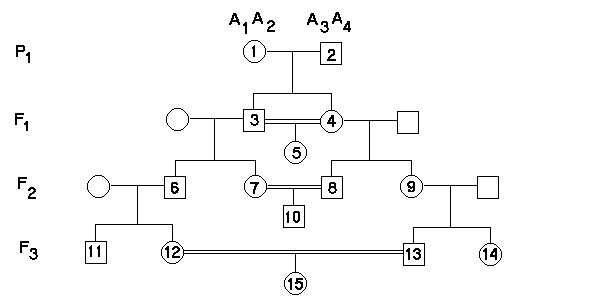

Relatedness in Pedigrees
The coefficient
of
relatedness (r)
is the fraction of alleles that two individual have in common.
If two
individuals are related, their offspring will be inbred.
Disentangling genetic vs popular meaning of 'inbreeding': In the population genetic sense, inbreeding is the fraction of alleles shared because of common ancestry. Inbreeding does not require preferential mating of relatives (the popular understanding), it occurs necessarily in any closed population with a finite number of individuals, such that all individuals eventually become related to a greater or lesser degree. Some natural populations and human societies are measurably 'inbred' to a greater degree than expected: several human cultures favor brother-sister marriages as a means of retaining dynastic power or wealth.
Ex.:
Relatedness between parent & offspring is 1/2:
the
child inherits one-half its alleles from each parent.
Relatedness
between full sibs is also 1/2:
each
child inherits one-half is alleles from each parent,
half
of these will be inherited by the sib as well,
and
full sibs share two parents:
(1/2)(1/2)
+ (1/2)(1/2) = 1/2
Relatedness
between first cousins is 1/8:
the
relatedness between their full-sib parents is 1/2,
each
cousin is related to its parent by 1/2:
(1/2)(1/2)(1/2)
= 1/8
| Relationship | Description | Example | r | F of offspring |
| Parent / Offspring | Transmission of
1 of 2 alleles per locus |
## 2 & 4 | 1/2 | 1/2 = (2)(1/2)(1/4) |
| Full sibs | offspring of same parents | ## 3 & 4 | 1/2 | 1/4 = (4)(1/4)2 |
| Half sibs | offspring with one parent in common | not shown | 1/4 | 1/8 = (2)(1/4)2 |
| 1st cousins | offspring of full sibs | ## 7 & 8 | 1/8 | 1/16 = (4)(1/8)2 |
| 2nd cousins | offspring of 1st cousins | ## 12 & 13 | 1/16 | 1/64 = (4)(1/16)2 |